According to legend, the British ruler King Arthur wielded a powerful sword called Excalibur in battle — and the weapon may have had magical powers.
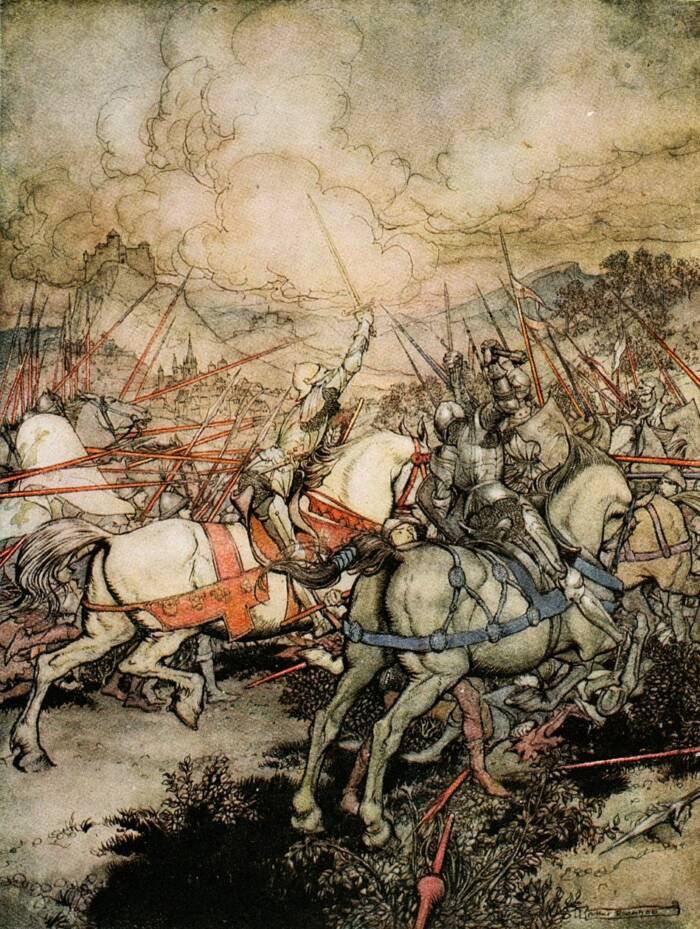
Public DomainKing Arthur’s sword, Excalibur, makes up an important part of his legend.
In his 12th-century text History of the Kings of Britain, Geoffrey of Monmouth describes a battle between King Arthur and a Saxon army. The battle isn’t going well for King Arthur and his men — until Arthur draws his Excalibur sword and charges straight toward the enemy ranks.
“Whomsoever he touched… he slew at a single blow,” Geoffrey of Monmouth writes, “nor did he once slacken in his onslaught until that he had slain four hundred and seventy men single-handed with his sword.”
Excalibur is well-known as King Arthur’s sword, but there’s more to this famous weapon than meets the eye. Here’s everything you need to know about Excalibur, from its mythical origins, to its role in the King Arthur legend, to whether or not this powerful sword ever really existed.
The History Of Powerful Swords In Myths
Powerful swords have long played an important role in Celtic legend. Irish mythology describes a hero named Fergus mac Róich who wields a sword named Caladbolg. Welsh mythology, possibly building upon the Irish tale, describes King Arthur in early legends as having a sword called Caledvwich.
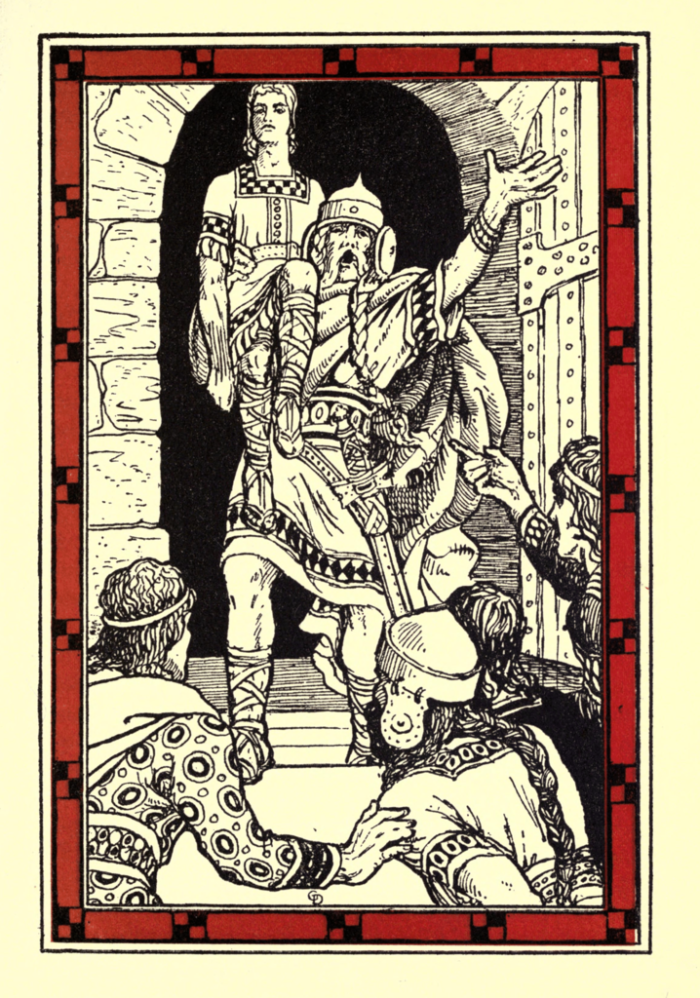
Public DomainThe Irish myth of Fergus mac Róich (seen here) and his sword Caladbolg may have helped inspire the enduring legend of King Arthur and his Excalibur sword.
These legends probably built upon even earlier fabled swords that appeared in myths. Julius Caesar and Attila the Hun purportedly had swords with incredible powers, for example, and some French, Norse, and Japanese legends describe “magic” swords in their mythologies.
In the 12th century, Geoffrey of Monmouth also built upon earlier legends when he sat down to write the History of the Kings of Britain. Writing in medieval Latin, he took the Welsh “Caledvwich” — which came from the Latin word chalybs (steel) — and called King Arthur’s sword “Caliburnus.”
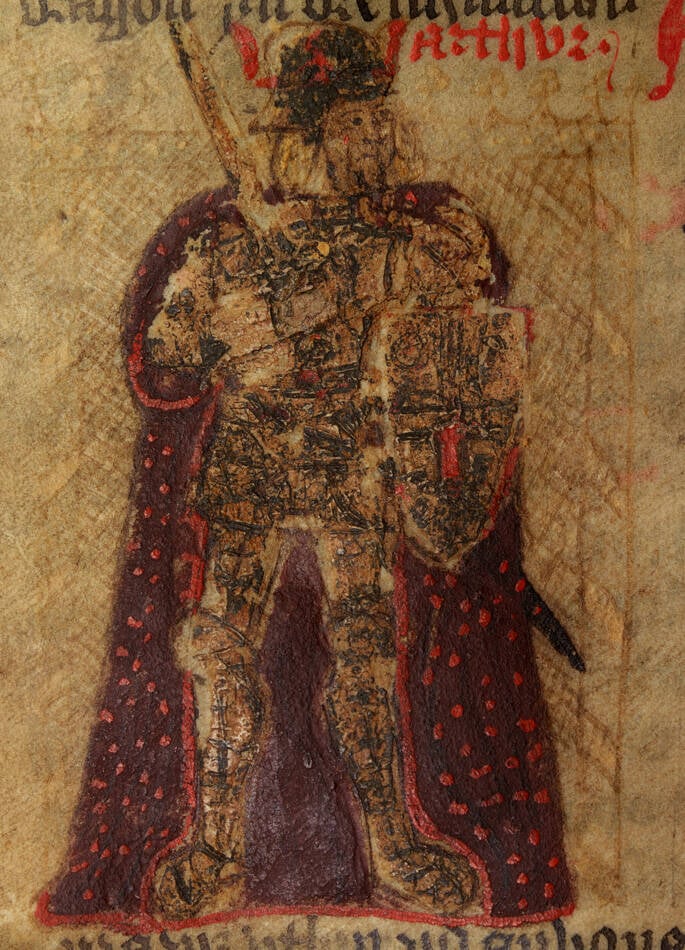
National Library of WalesA depiction of King Arthur in a 15th-century Welsh version of the History of the Kings of Britain.
French poets translated Caliburnus to Chaliburn, and then Escalibor. When the King Arthur legend was translated from French to English, this sword name became the one that most people know best: Excalibur.
But even though the Excalibur sword is famous, the weapon’s role in Arthurian legend is often misunderstood today.
The Excalibur Sword In The King Arthur Legend
Perhaps the most famous story in the King Arthur legend is the tale of the Sword in the Stone. This part of the myth was first described by the 12th-century French poet Robert de Boron in his epic poem Merlin (parts of which were lost). The poem describes a sword set in stone, which can only be pulled out by the rightful king of Britain. When a young Arthur succeeds in freeing the sword, he cements his place as Britain’s king.
But traditionally, the Sword in the Stone is not Excalibur.
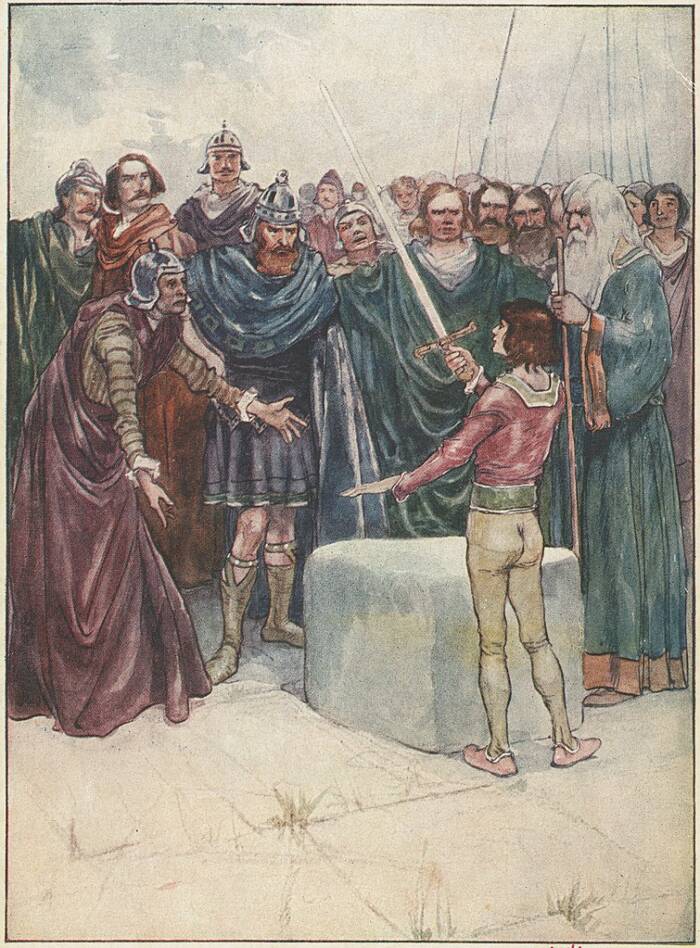
Public DomainKing Arthur freeing the Sword in the Stone. This weapon is often conflated with the Excalibur sword, but most scholars agree that they’re different swords — even though some versions of the legend give both weapons the name Excalibur.
This sword has come to be connected with Excalibur, but Arthurian legend states that it’s broken during Arthur’s battle with King Pellinore. In the aftermath, Merlin takes Arthur to see the Lady of the Lake. She bestows the Excalibur sword and a magical scabbard upon the young king.
Descriptions of the sword vary from legend to legend, however.
Geoffrey describes Excalibur as “the best of swords, that was forged within the isle of Avallon.” In Thomas Malory’s 15th-century text Le Morte d’Arthur, however, Merlin dismisses the power of the sword, telling Arthur that it’s actually the scabbard that’s “worth ten of the sword.” Excalibur is sometimes described as being encrusted with jewels like topaz and jacinth, and sometimes as having the inscriptions “Take me up” and “Cast me away.”
But in all versions of the Arthurian legend, it’s an incredibly powerful weapon.
“[T]hen he drew his sword Excalibur, and it was so bright in his enemies’ eyes that it gave light like thirty torches,” Malory writes of Arthur’s battle with King Lot. “Therewith he put them back and slew many people.”
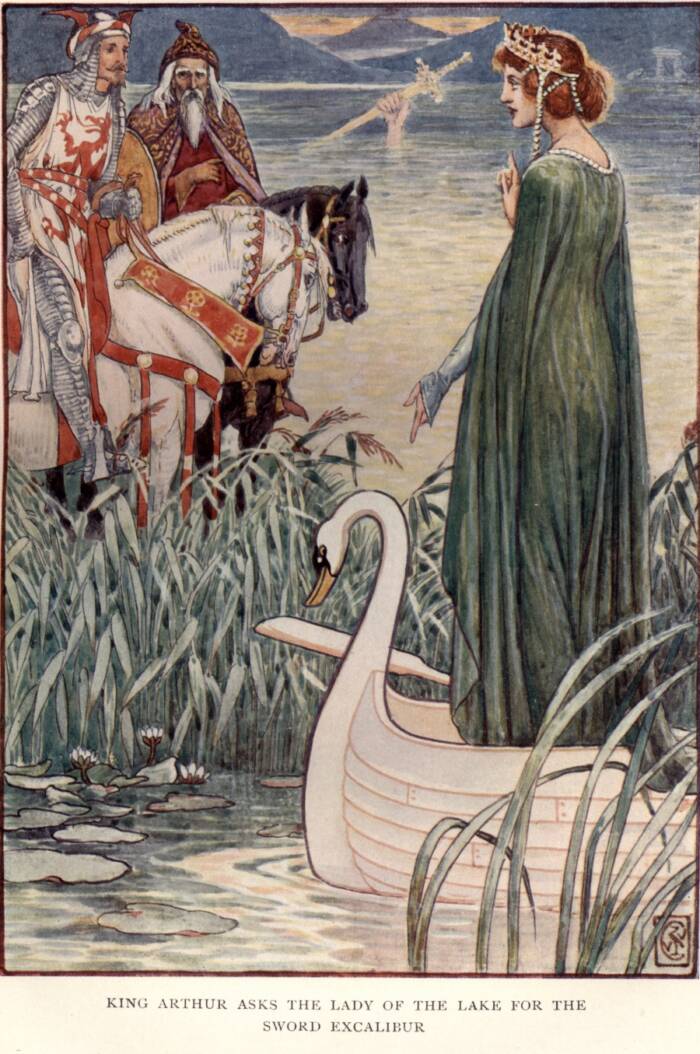
Public DomainKing Arthur receiving the Excalibur sword and its magical scabbard from the Lady of the Lake. This powerful weapon protected him in battle, but the loss of the sword’s scabbard ultimately led to Arthur’s demise.
But in the end, Excalibur and its scabbard lead to King Arthur’s downfall. Arthur’s sister, hoping to defeat him, steals the sword and scabbard and gives them to her lover. When Arthur kills her lover, she throws the scabbard into a lake. This allows Arthur’s illegitimate son, Mordred, to defeat his father.
In his dying moments, Arthur orders a knight to throw the Excalibur sword into the lake where he first received it. Though the knight — named Bedivere (or Bedevere) in some legends and named Griflet (or Girflet) in others — refuses twice to dispose of such a priceless weapon, he eventually tosses the sword into the lake. Legend states that a hand then emerges from the water to catch the sword and pull it into the depths.
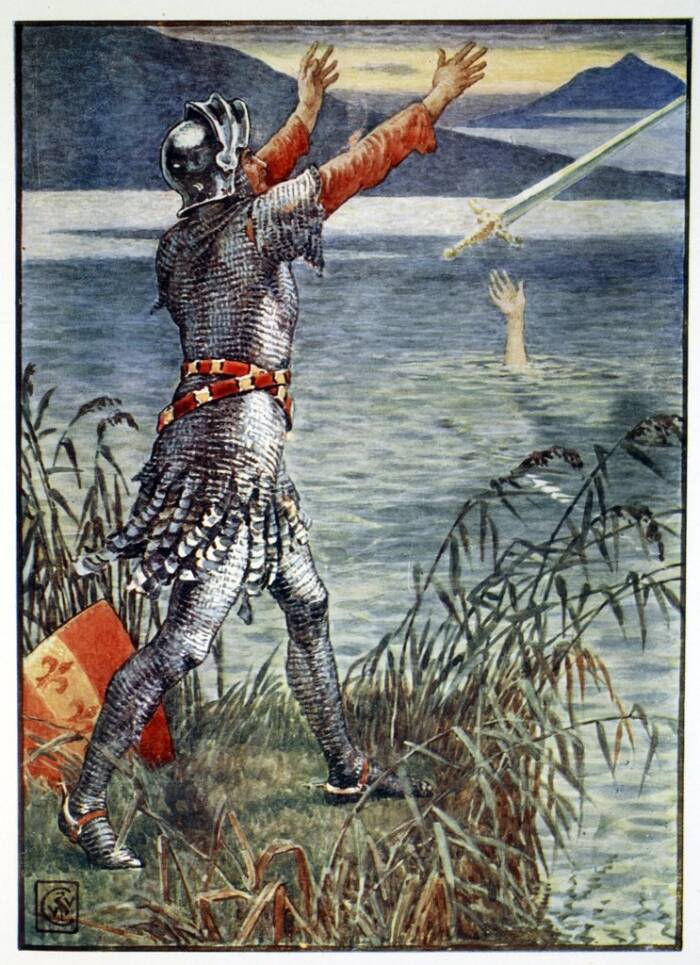
Public DomainA knight — either Bedivere or Griflet — throwing the Excalibur sword into the lake after King Arthur’s death.
As History of Swords notes, this matched a real British tradition of throwing a warrior’s belongings into a lake to ensure a safe passage to the afterlife.
But does anything else about Excalibur ring true?
The Truth Behind The Excalibur Myth
Was Excalibur real? That depends on another question. Was King Arthur real?
When Geoffrey of Monmouth wrote History of the Kings of Britain and described King Arthur and the Excalibur sword, he claimed to be drawing from a lost Celtic manuscript. Whether or not this was true — or if Geoffrey simply made the story up — he didn’t totally invent the King Arthur legend.

Universiteitsbibliotheek UGent/Wikimedia CommonsA fragment from the History of the Kings of Britain, where Geoffrey of Monmouth first described Excalibur as Caliburnus.
King Arthur was first mentioned in the 9th century by a Welsh historian named Nennius, who described 12 battles that Arthur fought. Though it would have been difficult for any one person to fight in all 12 of the battles that Nennius mentioned, especially since they stretched over such a long period of time, Arthur’s legend spread during the subsequent centuries.
Some believe that Arthur may have been based on a real warrior who led the Britons to victory over the Saxons at the Battle of Mount Badon, which took place sometime around the sixth century. However, surviving contemporary sources about that battle don’t mention King Arthur at all.
Thus, it’s difficult to know if King Arthur was a mythical figure, a real person, or something in between. If he did exist, then Excalibur may be based on a real sword that he wielded — or it may have served as a symbol of his formidable power. Either way, the legend of the Excalibur sword is likely drawn from a mix of tales that feature powerful swords.
Interestingly, throughout the years, there have been a number of artifacts colloquially nicknamed Excalibur, including a 1,000-year-old iron sword found sticking straight up out of the ground in Spain and even a late 20th-century sword that was tossed into a lake in England. Meanwhile, some have speculated that a sword allegedly discovered in Glastonbury Abbey in 1191 could have belonged to King Arthur, or at least a warrior who inspired him. However, there’s no hard evidence the “real” Excalibur has ever been found.
Excalibur is far from the only sword to appear in myth, but it’s perhaps the most famous. Wielded by King Arthur and later sunk in a lake, Excalibur shines through the ages — with the “light like thirty torches.”
After reading about the legendary Excalibur sword, discover the story of the Holy Grail, from its murky Biblical origins to its role in Arthurian legend. Or, read about the Knights Templar and their possible connection to King Arthur.





